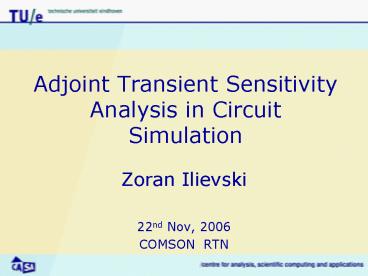Adjoint Transient Sensitivity Analysis in Circuit Simulation PowerPoint PPT Presentation
1 / 30
Title: Adjoint Transient Sensitivity Analysis in Circuit Simulation
1
Adjoint Transient Sensitivity Analysis in Circuit
Simulation
- Zoran Ilievski
- 22nd Nov, 2006
- COMSON RTN
2
Overview
- Introduction (circuit analysis, COMSON)
- Transient Sensitivity, the direct approach
- The backward adjoint method
- Implementation
- Results
- Conclusions and further work
3
Overview
- Introduction (circuit analysis, COMSON)
- Transient Sensitivity, the direct approach
- The backward adjoint method
- Implementation
- Results
- Conclusions and further work
4
COMSON
- COupled Multiscale Simulation and Optimization in
Nanoelectronics
- Eindhoven
- Wuppertal
- Bucharest
- Calabria
- Catania
- Infineon
- NXP / Philips
- STMicroelectronics
5
COMSON
- Develop as Software, a Demonstrator Platform
- Coupled simulation of devices, interconnects,
circuits, EM fields and thermal effects
- WP1 - Mathematical Modelling and Analysis
- WP2 - Demonstrator Platform
- WP3 - Model Order Reduction
- WP4 - Optimisation
- WP5 - E-learning
6
COMSON
WP3Coordination by NXP
- Parameter analysis (BUC)
- Nonlinear circuits (WUP)
- Implementation (WUP, BUC)
7
Circuit Equations
x(t) States j(x(t))
Current q(x(t)) Charge s(x(t)) Signal
p some parameter
8
Overview
- Introduction (circuit analysis, COMSON)
- Transient Sensitivity, the direct approach
- The backward adjoint method
- Implementation
- Results
- Conclusions and further work
9
Transient Sensitivity Analysis - TSA
- Each circuit has an intended functionality
- Circuits are made in silicon (SoC), can be
represented as a circuit diagram - It could react to small changes in parameter
values - For example, width-length of a resistor
10
TSA Typical Problems in which parameter
variation plays a role
- Important to manage available power to realize a
functionality - Change in parameters will affect this.
- Timing in circuits is VERY important.
- Change in parameter could cause a desired
functionality to perform with a delay.
11
Observation Function
- F, Power
- G, Energy
12
Inner Product Cost
Inner product is calculated at each time point,
very expensive.
13
Overview
- Introduction (circuit analysis, COMSON)
- Transient Sensitivity, the direct approach
- The backward adjoint method
- Implementation
- Results
- Conclusions and further work
14
Backward Adjoint Method - BAM
- Alternative to previous method
- Enables a cheap and clever calculation of the
inner product. - Introduction of a function ?(t)
- ?(t) has a related DAE that needs to be solved.
( complex transpose)
15
BAM Inner Product Cost Reduction
16
BAM Inner Product Cost Reduction
17
BAM Inner Product Cost Reduction
- is avoided by setting the initial
condition (valid for
DAE index 1) - is easily found from the steady state
DC condition, cheapest calculation - Backward integration of adjoint equation
enables that calculation of
18
BAM Inner Product Cost Reduction
Calculate the following
Substitution in the above will give the
sensitivity.
19
Overview
- Introduction (circuit analysis, COMSON)
- Transient Sensitivity, the direct approach
- The backward adjoint method
- Implementation
- Results
- Conclusions and further work
20
BAM Steps and Implementation
Forward step Calculation of x(t)
Euler-Backward application to circuit equations
- Newton-Raphson iteration gives with Newton
matrix - Time step control
21
BAM Steps and Implementation
- Backward differential formulation
- Ideally choose same step size as forward
integral, eliminates interpolation errors. - C and G matrices are time dependent, if original
circuit is linear they retain the same value
at each time t. Only need to calculate them
once.
22
BAM Steps and Implementation
Estimation of
23
BAM Steps and Implementation
24
Overview
- Introduction (circuit analysis, COMSON)
- Transient Sensitivity, the direct approach
- The backward adjoint method
- Implementation
- Results
- Conclusions and further work
25
Results
? 1 ? 20.025 ohm meters A1A20.0001
meters2 L10.02 meters Ap1110-6
meters2 d1110-6 meters
Calculating for L20.02,0.021,0.022m and
observing the 2nd resistor
26
Overview
- Introduction (circuit analysis, COMSON)
- Transient Sensitivity, the direct approach
- The backward adjoint method
- Implementation
- Results
- Conclusions and further work
27
Conclusions and further work
How fast is the adjoint method?
28
Conclusions and further work
- If the circuit description is linear, BAM is
immediately attractive, only one LU decomposition
is carried out. - Remaining main burden is the O(N3) LU
decomposition in the backward integration for
non-linear circuits where the time-varying CG
matrices force an LU decomposition at each time
step. - Noticing the output r F x P ltlt N this suggest a
model order reduction approach could be taken for
non-linear circuits.
29
Conclusions and further work
- In MOR we are looking for a matrix
such that - Which we can then use to reduce C G
- Which MOR method could we use?
30
Conclusions and further work
- Proper orthogonal decomposition is ideal
- POD requires snap shots of the output of a
system, which we have.

